Ijraset Journal For Research in Applied Science and Engineering Technology
- Home / Ijraset
- On This Page
- Abstract
- Introduction
- Conclusion
- References
- Copyright
CO2 Flooding and Water Sprinkler System by the Means of Double Routing System
Authors: Akshay Saykar, Chaitanya Tuwar, Prajwal Thakare, Dr. Amol Raundal
DOI Link: https://doi.org/10.22214/ijraset.2022.44857
Certificate: View Certificate
Abstract
In introductory discuss the complexities of relationship between human and fire and the status of human efforts of control the disastrous effects of fire. A fire subsequent section examines characteristics and behavior of fire, with a special note on smoke movement in building and industry. The text covers these topics regarding fire hazards, fire hazards of specific material such as wood, fibres and explosive. Industrial and process fire hazards special fire protection and prevention issues regarding indoor and outdoor storage practices, material handling equipment, electrostatics ignition source etc. Fire safety in building design and construction with attention to high rise structure. Fire hazards of various types of occupied structure including residential business, industrial and educational. The role and responsibilities of public fire departments and water supplies discussions of fire protection devices and systems including fire alarms, detection devices guard’s services, extinguishment agents, water sprinklers, special system and portable fire extinguisher. Fire hazards of various types of occupied structure including residential buildings, industrial and educational buildings. The role and responsibilities of fire protection devices and systems including fire alarms, detection devices, extinguishment agents, special system, and CO2 fire extinguisher.
Introduction
I. INTRODUCTION
Fire is the rapid oxidation of a material (the fuel) in the exothermic chemical process of combustion, releasing heat, light, and various reaction products. Fire in its most common form can result in conflagration, which has the potential to cause physical damage through burning. Fire is an important Process that affects ecological systems around the globe. The positive effects of fire include stimulating growth and maintaining various ecological systems. Its negative effects include hazard to life and property, atmospheric pollution, and water contamination. Which brings in The Fire Fighting Systems, Fire protection (Fire Fighting systems) is the study and practice of mitigating the unwanted effects of potentially destructive fires.
II. TYPES OF FIRE
A. CLASS “A” FIRES
A class “A” fire can involve any material that has a burning ember or leaves an ash. Common examples of class “A” fires would be wood, paper, or pulp. The preferred method for extinguishing class “A” fires is to remove the heat. Water is the most common agent, but others such as dry chemical, halon, halogenated agents and foamcan be used effectively.
B. CLASS “B” FIRES
A class “B” fire involves flammable liquid or gas. Familiar examples would be gasoline, oil, propane, and natural gas. A variety of fire extinguishing agents is used on flammable liquid fires employing all theories of fire extinguishment. Which agent is best to use is dependent upon the circumstances involved. Flammable liquids do not ignite in their liquid state; rather it is the vapor’s being generated by these liquids that ignite. The mixture of oxygen and flammable vapor’s in proper proportion needs only an ignition source to start the combustion process.
C. CLASS “C” FIRES
Class “C” fires involve live electrical equipment and require the use of an extinguishing agent and/or extinguisher that will not conduct electricity back to the fire fighter(s). Electricity is an energy source and an ignition source, but by itself will not burn. Instead, the live electrical equipment may serve as a source of ignition for a class “A “fire such as insulation or packing, or a class “B” fire.
D. CLASS “D” FIRES
Class “D” fires involve exotic metals such as titanium, zirconium, magnesium, and sodium. These fires require special agents such as dry powders and special application techniques. The extinguishing agents and techniques used on “A”, “B”, or “C” fires will not work on class “D” fires, nor will the agents and techniques used for class “D” fires work on any other classification of fire. Many common agents like water will actually react to burning metals and increase the intensity of the fire in a violent manner.
E. CLASS “K” FIRES
Class “K” fires involve cooking media. These can be any animal or vegetable-based fats or oils. These fires require special agents such as wet chemical extinguishers and systems that are alkaline in nature and have superior cooling capabilities. The entire mass of the cooking medium in a deep fat fryer must be secured and cooled below its auto ignition point in order to achieve complete extinguishment.
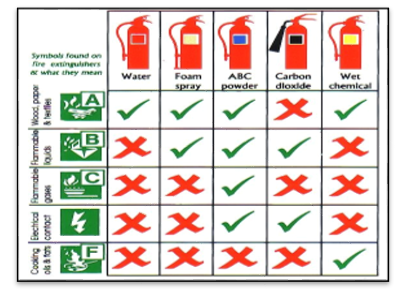
III. CLASSES OF FIRE EXTINGUISHER
Depending on the specific fire types, fire extinguishers are also classified into six groups as listed below:
- Class A fire Extinguisher: These fire extinguishers are used to put out class A fires characterized by fire from ordinary solid or dust combustibles like wood, paper, textile, plastic, fabric, cardboard, etc.
- Class B fire Extinguishers: Class B fire extinguishers are used to prevent Class B fire hazards from flammable liquids like grease, gasoline, oil (except cooking oil), paint, etc.
- Class C fire Extinguisher: Class C fires originated from flammable gases like methane, butane, propane, hydrogen, etc. are best handled using class C fire extinguishers.
- Class D fire Extinguisher: Class D fire extinguishers are widely used to put out fires generated from combustible metals, such as magnesium, sodium, potassium, lithium, titanium, or aluminium.
- Class E fire Extinguisher: These fire extinguishers are used to extinguish fires that originated from live electrical sources. However, in many countries, this is not recognized as a separate fire class because once the electric power supply is switched off it can be considered as any of the other five classes.
- Class F fire Extinguisher: Class F fire extinguishers find their use to extinguish class F fires characterized by fires from cooking oils, vegetable oils, fats, butter, etc.
IV. TYPES OF FIRE EXTINGUISHER
A. Water Fire Extinguishers
Water fire extinguishers are the most economic and simplest among all fire extinguisher types. They are suitable to put off class A fires. All water extinguishers have a bright red label. Water fire extinguishers are widely used in shops, domestic buildings, offices, retail premises, schools, hotels, warehouses, hospitals, etc. Water fire extinguishers are of four types:
- Water jet extinguishers
- Water spray extinguishers
- Water extinguishers with additives, and
- Water mist extinguishers
A water jet extinguisher throws a water jet at the burning material forcing the material to cool down preventing re-ignition. Water spray fire extinguishers use a very fine spray of water droplets surrounded by air to extinguish the fire. A foaming chemical is added in the water fire extinguishers with additives that help in effective soaking into the burning materials. The addition of chemicals can cause a smaller fire extinguisher to produce the same fire fighting capability as a larger, water-only, fire extinguisher. Water mist fire extinguishers apply water in the form of fog or mist. The generated mist droplets are much smaller as compared to those formed in the water spray fire extinguisher. Smaller droplets possess larger surface areas in relation to their size. Such smaller droplets evaporate quickly absorbing the heat energy from the fire.
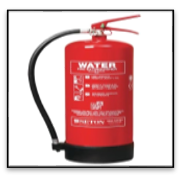
B. Foam Fire Extinguishers
Foam fire extinguishers find their application to put out class A and class B fires. They blanket the fire with foam generated when the spray hits the air. This blanket prevents the vapours from reaching the air. Also, the water in the foam provides a cooling effect to prevent re-ignition. Foam fire extinguishers carry a cream label.
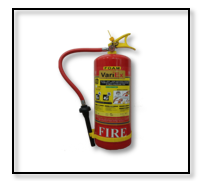
C. Powder Fire Extinguishers
Powder fire extinguishers are multi-purpose extinguishers with numerous advantages. It is one of the most common extinguishers in wide use as powder extinguishers can be effectively used on Class A, B, C, and E fires. Fine chemicals in powder form as extinguishing agents are released by the powder extinguishers to blanket the fire and suffocate it. The common powder is mono-ammonium phosphate. However, as they do not cool the fire, there is a possibility of re-ignition. Also, powders can create a loss of visibility and breathing problems. So, powder extinguishers should be used as the last resort. Powder fire extinguishers carry a blue label.
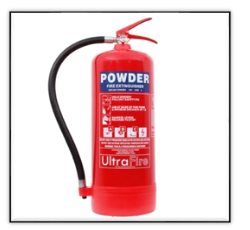
D. Carbon Di-Oxide Fire Extinguishers
A carbon dioxide fire extinguisher (CO2) is ideal for fires involving electrical hazards (Class E). This is one of the cleanest types of fire extinguishers in commercial use and requires no clean-up after use. CO2 fire extinguishers can also be used on class B fires involving flammable liquids. Carbon dioxide fire extinguishers blanket the fire by cutting off the air supply which in turn removes oxygen, required for fire to continue. CO2 fire extinguishers carry a black label
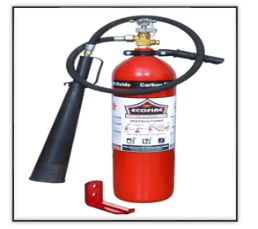
E. Fire Protection System
- Fire Extinguishers
- Fire sprinkler systems
- CO2 Flooding system
- Hydration system
And other systems like,
a. Fire Alarm systems
b. Smoke detector systems
CO2 Flooding System – CO2 flooding system or central bank CO2 system is one of the common fixed fires fighting system installed on most of the ships. It releases carbon dioxide (CO2) in bulk quantity to a protected space under fire. Smothering action of CO2 extinguishes the fire thereby preventing spreading of fire to other parts of the ship. It consists of several CO2 cylinders located in a separate room, called CO2 room.
Fire Sprinkler Systems: - A Fire Sprinkler System is an active fire protection method, consisting of a water supply system, providing adequate pressure and flow rate to a water distribution piping system, onto which fire sprinklers are connected. Although historically only used in factories and large commercial buildings, systems for homes and small buildings are now available at a cost-effective price. Fire sprinkler systems are extensively used worldwide, with over 40 million sprinkler heads fitted each year. Even though Fire Sprinkler Systems are a Life Saving System and are not designed to protect the building, 96% of buildings that had fires and were completely protected by fire sprinkler systems were controlled by the fire sprinklers alone.
This Research Suggest the possibility of use of CO2 flooding and water sprinkler system by the means of double-walled pipe system.
F. Objectives of this Study
The aim is to Protect Human Life and Property.
V. CO2 FLOODING SYSTEM
A. CO2 Flooding System
CO2 flooding system or central bank CO2 system is one of the common fixed fires fighting system installed on most of the ships. It releases carbon dioxide (CO2) in bulk quantity to a protected space under fire. Smothering action of CO2 extinguishes the fire thereby preventing spreading of fire to other parts. It consists of several CO2 cylinders located in a separate room, called CO2 room. These bottles contain CO2 in liquid state. When the fire in a protected space goes out of control or in a situation when the fire is not able to extinguish by local firefighting media, CO2 flooding system comes into picture. CO2 from the bottles directed via common manifold, main valve and distribution pipe lines to nozzles through which it is released to the protected space for fire extinction. Due to safety reasons, the CO2 flooding system is manually released from a release cabinet located outside the protected space.
B. Why CO2 is used?
Carbon dioxide is the fire extinguishing medium used in CO2 flooding system. It is an effective fire suppression agent applicable to a wide range of fire hazards. It has a high rate of expansion which allows it to work fast. When applied to a fire, CO2 provides a heavy blanket of gas that reduces the oxygen level to a point where combustion cannot occur. Since carbon dioxide is a gas, there is no cleaning up associated with a system discharge.
There are several advantages for the CO2 as a fire fighting medium as follows,
- Density is 1.5 times higher than air. So CO2 settles down and displaces air.
- It can be easily liquefied and bottled.
- 20% – 30% CO2 concentration extinguishes fire by smothering
- Non-corrosive
- Non- conductor of electricity
- No residues left after application
- No deterioration with age
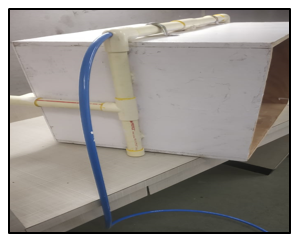
C. Fire Sprinkler System
A fire sprinkler system is an active fire protection method, consisting of a water supply system, providing adequate pressure and flow rate to a water distribution piping system, Onto which fire sprinklers are connected. Although historically only used in factories and large commercial buildings.
- Advantages of Fire Sprinkler System
a. Sprinkler systems are automatic and respond at all times.
b. Significantly less heat and smoke is generated if the fire is extinguished at inception
c. Property damage is reduced
d. Fire fighters are exposed to much less danger if the fire is kept in check by a sprinkler system.
Even though Both the Fire protection system, the CO2 Flooding System and Fire Sprinkler System, are able to extinguish fire.
The Question is why to use CO2 flooding and water sprinkler system by the means of double-walled pipe system?
This Research is mainly done considering. To use any of the Two System, According to the Area of use or the material stored in the area and for the possibility of Person getting stuck in the CO2 Flooding.
2. Disadvantages of using CO2 Flooding
a. CO2 is highly asphyxiating. 9% concentration causes unconsciousness within minutes
b. Very little cooling effect. So there is danger of re-ignition.
c. When discharged, solid CO2 particles present and generate sufficient static electricity to produce spark.
3. Disadvantages of Fire Sprinkler System
a. The structure of sprinkler system.
b. The maintenance issues and problems of water shortage etc.
First sprinkler system used in Double-walled pipe system. A dry pipe sprinkler system is one in which pipes are filled with pressurized air or nitrogen, rather than water. This air holds a remote valve, known as a dry pipe valve, in a closed position. Located in a heated space, the dry-pipe valve prevents water from entering the pipe until a fire causes one or more sprinklers to operate. Once this happens, the air escapes and the dry pipe valve releases. Water then enters the pipe, flowing through open sprinklers onto the fire.
4. Advantages of using dry Pipe Fire Sprinkler Systems Include:
Dry pipe sprinkler systems provide automatic protection in spaces where freezing is possible. Typical dry pipe installations include unheated warehouses and attics, outside exposed loading docks and within commercial freezers.
Many people view dry pipe sprinklers as advantageous for protection of collections and other water sensitive areas. This perceived benefit is due to a fear that a physically damaged wet pipe system will leak while dry pipe systems will not. In these situations, however, dry pipe systems will generally not offer any advantage over wet pipe systems. Should impact damage happen, there will only be a mild discharge delay, i.e. 1 minute, while air in the piping is released before water flow.
CO2 Flooding system to be used in double -walled pipe system.
VI. RESULT
After comparing the system in separated use the double-walled pipe system of CO2 Flooding and Fire Sprinkler System have the advantage. Advantages of using according to situation (properties of the material) in the room and also can be used at a same time increase the extinguishing property and as in case if the person is stuck inside he should be able to turn off the CO2 Flooding.
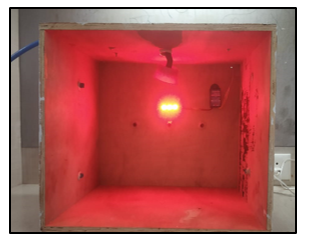
Conclusion
This project gives the knowledge of combining two extinguishing systems (Fire Protection System) are as follows, • CO2 flooding system. • Sprinkler system. This Research concludes that the combine process of CO2 flooding and Sprinkler system is possible to use and can be applied and can be used according to situation e.g. If any human being gets trapped in server room, which has C02 flooding type of extinguishment which may lead to death of the person by means of suffocation. By introducing this Research concept, we would be able to save the human life, by using water Sprinkler system, and shutting of the CO2 system and down the power of the building.
References
[1] Fire Protection Handbook, 17th Ed. Quincy, MA: National Fire Protection Association, 1991. [2] Fang, J.B. \"Fire Development in Residential Basement Rooms.\" National Institute of Standards and Technology. [3] NFPA 921, Guide for Fire and Explosion Investigations, 1992 Ed. Quincy, MA: National Fire Protection Association. [4] NFPA 12, Standards on Carbon Dioxide Extinguishing System, 2000. [5] NFPA 2001, Standards on Clean agents Fire Extinguishing Systems. [6] ISO Standards 6183, 1990, Fire Protective Equipment, Carbon Dioxide Systems for use on premises, Design and Installations. [7] Reclamation Safety and Health Standards, Bureau of Reclamation, 2001. [8] CO2 Fire Protection Study For Hydrogenates- Reports of finding, Bureau of Reclamation, 1984. [9] NFPA 12, Section 1-6, Personal Safety, contains requirements to protect personnel. [10] 29 CFR Parts 1910. 165, Employee Alarm System. [11] 29 CFR Part 1910.164, Fire Detection System. [12] NFPA 325M, Manual on Fire Hazard Properties of Flammable Liquids, Gases, and Volatile Solids, 1991 Ed. Quincy, MA: National Fire Protection Association. [13] Industrial fire sprinkler system and fire safety advice centre from the original on 16 Januarys 2013. [14] History of sprinkler system associated with fire protection. [15] NFPA 750. [16] CO2 flooding system associated with fire protection. [17] Fundamental of Industrial Safety and Health. [18] CO2 flooding system fixed firefighting system. [19] Dry pipe fire sprinkler system. [20] CCOHS 1990. Carbon Dioxide Chemical In fogram. Canadian Centre for Occupational Health and Safety, Hamilton, Ontario, October.
Copyright
Copyright © 2022 Akshay Saykar, Chaitanya Tuwar, Prajwal Thakare, Dr. Amol Raundal. This is an open access article distributed under the Creative Commons Attribution License, which permits unrestricted use, distribution, and reproduction in any medium, provided the original work is properly cited.

Download Paper
Paper Id : IJRASET44857
Publish Date : 2022-06-25
ISSN : 2321-9653
Publisher Name : IJRASET
DOI Link : Click Here
 Submit Paper Online
Submit Paper Online

